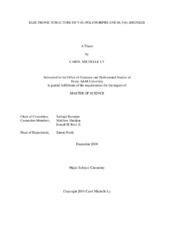| dc.contributor.advisor | Banerjee, Sarbajit | |
| dc.creator | Ly, Carol Michelle | |
| dc.date.accessioned | 2019-01-23T19:55:36Z | |
| dc.date.available | 2020-12-01T07:33:29Z | |
| dc.date.created | 2018-12 | |
| dc.date.issued | 2018-11-27 | |
| dc.date.submitted | December 2018 | |
| dc.identifier.uri | https://hdl.handle.net/1969.1/174445 | |
| dc.description.abstract | The energy landscape of vanadium oxide (Vv2Ov5) showcases a rich abundance of energetically proximate minima representing different metastable phases. In addition to the multiple polymorphs of Vv2Ov5, the open-framework structures can accommodate varying concentrations of metal ions within their structure to form mixed-metal oxide bronzes with the formula MvxVv2Ov5. The bonding motif of each polymorph is determined by the connectivity of V—O bonds as well as the different inserted metal ions (M) and their stoichiometry (x); these materials thus serve as an excellent sandbox for elucidating structure—function correlations. The crystal structures of these semiconductors affect the electronic structure. Both the atomistic structure as well as the electronic structure determine the utility of these materials in applications such as energy storage and switchable devices. An electronic structure property of utmost importance to functional applications is the band gap. The study here uses diffuse reflectance spectroscopy paired with Kubelka-Munk analysis to determine the band gaps of well-characterized powders of these materials.
The discovery of new cathode materials that can intercalate cations and allow for both ionic and electronic transport is an urgent imperative for electrochemical energy storage. Materials with smaller band gaps tend to be better potential candidates than those with large band gaps owing to their better electronic conductivities and better ability to diffuse polarons. The band gaps of each polymorph of Vv2Ov5 are compared to evaluate the extent of covalent hybridization.
The deduced band gaps of polymorphs of Vv2Ov5 are furthermore of importance for energy harvesting. By synthesizing heterostructures of Vv2Ov5 and II-VI quantum dots, type-II charge-separated interfaces can be constructed and the separated carriers can be utilized for photocatalytic
reactions. The charge separation depends sensitively on the energetic offsets between the two semiconductors.
In addition, the mixed metal-oxide bronzes studied here exhibit metal-insulator transitions dependent on the concentration of metal-ions present. Trends in band gap values with the changes in metal cation content shows the strong correlation of structure and application. | en |
| dc.format.mimetype | application/pdf | |
| dc.language.iso | en | |
| dc.subject | V2O5 polymorphs | en |
| dc.subject | V2O5 bronzes | en |
| dc.subject | Kubelka-Munk | en |
| dc.subject | diffuse reflectance | en |
| dc.subject | band gap | en |
| dc.title | Electronic Structure of V2O5 Polymorphs and MxV2O5 Bronzes | en |
| dc.type | Thesis | en |
| thesis.degree.department | Chemistry | en |
| thesis.degree.discipline | Chemistry | en |
| thesis.degree.grantor | Texas A & M University | en |
| thesis.degree.name | Master of Science | en |
| thesis.degree.level | Masters | en |
| dc.contributor.committeeMember | Sheldon, Matthew | |
| dc.contributor.committeeMember | Ross, Joseph H | |
| dc.type.material | text | en |
| dc.date.updated | 2019-01-23T19:55:37Z | |
| local.embargo.terms | 2020-12-01 | |
| local.etdauthor.orcid | 0000-0003-1961-964X | |


